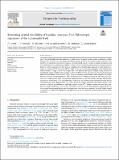Por favor, use este identificador para citar o enlazar a este item:
http://hdl.handle.net/10261/348292COMPARTIR / EXPORTAR:
 SHARE
BASE SHARE
BASE
|
|
| Visualizar otros formatos: MARC | Dublin Core | RDF | ORE | MODS | METS | DIDL | DATACITE | |

| Título: | Estimating spatial variability of baseline isoscapes from fish isotopic signatures at the community level |
Autor: | Ortíz, Juan José; Preciado, Izaskun; Hidalgo, Manuel CSIC ORCID; González-Irusta, José Manuel; Rabanal, I; López-López, Lucía | Palabras clave: | Fish community Demersal GAMs Isotopic baseline Linear mixed-effects models Stable isotopes Trophic ecology |
Fecha de publicación: | feb-2024 | Editor: | Elsevier | Citación: | Progress in Oceanography 221: 103205 (2024) | Resumen: | One of the main limitations in the application of stable isotopes to marine trophic ecology is obtaining a reliable baseline upon which to calculate isotopic enrichment. Isotopic baselines are variable in space and time, influenced by several environmental factors such as terrestrial runoff, oceanic currents or primary production, and thus, investigating their patterns of variability is essential to gain confidence in the estimates of trophic position based on isotopic signatures. We here propose a multispecies and multitrophic approach to study baseline isoscapes for nitrogen (¿15N) and carbon (¿13C), which we test on the demersal community of the Northwestern Iberian Peninsula. Using a set of 372 isotopic data of 11 demersal fish species sampled during autumn, we modelled the spatial variability of the isotopic baseline (for ¿15N and ¿13C separately) by removing the biological effect of species identity and individual length. Using the residuals of these models, which represent the isotopic baseline anomalies, we investigated the effect of environmental variables in driving the observed spatial patterns. Our results identify clear and consistent spatial patterns for the ¿13C isotopic baseline. This isoscape achieved the lowest values in the westernmost part of the study area (Galician coast) increasing towards the east (Cantabrian Sea). This spatial pattern was mostly driven by primary production and organic matter in the sediment, reflecting the influence of upwelling intensity in the ¿13C isotopic baseline over the study area. Baseline isotopic anomalies of ¿15N, on the other hand, did not show clear spatial patterns, suggesting that for this isotopic baseline spatial patterns at the regional scale might not be as consistent. Our study brings forward the potential of multispecies isotopic data for approximating the environmental isotopic baselines for the whole ecosystem. | Versión del editor: | https://doi.org/10.1016/j.pocean.2024.103205 | URI: | http://hdl.handle.net/10261/348292 | Identificadores: | doi: 10.1016/j.pocean.2024.103205 issn: 0079-6611 e-issn: 1873-4472 |
| Aparece en las colecciones: | (IEO) Artículos |
Ficheros en este ítem:
| Fichero | Descripción | Tamaño | Formato | |
|---|---|---|---|---|
| Ortiz_2024_Progress in Oceanography.pdf | Artículo principal | 6,47 MB | Adobe PDF |  Visualizar/Abrir |
| Supplem_Ortiz_2024_Progress in Oceanography.docx | Datos suplementarios | 4,89 MB | Microsoft Word XML | Visualizar/Abrir |
CORE Recommender
Este item está licenciado bajo una Licencia Creative Commons

